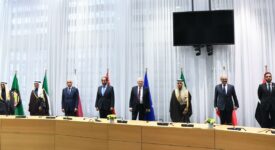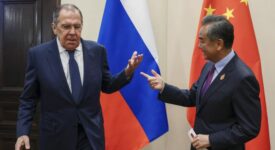After years of complaining that the US spends too much on defending wealthy allies, President Donald Trump has confirmed that he intends to reduce the number of US troops stationed in Germany to 25,000, from the current figure of around 34,500. There are still no details of Trump’s plans for forces taken from Germany, which hosts more than half of all US forces in Europe. Trump agreed last year to transfer 1,000 troops from Germany to Poland and he also implied last month that the US would now transfer more. The announcement, made without formally consulting Germany or NATO, has caused disquiet in Europe, raising worries about the U.S. long-term commitment to European security. But Europeans need to move from vague concern to strategic reflection and concerted action.
The threats to Europe have not diminished. In recent years, Russia has strengthened its forces facing NATO and, in early June, Moscow said that it had reinforced its Western Military District. Trump’s announcement of troop reductions in Germany came soon afterwards. But Russia is not the only problem: there are conflicts all around Europe’s southern borders as well – in the Middle East, North Africa and the Sahel. Without substantial American help, Europe barely has the capabilities to contain them, let alone bring them to an end. But, still, Trump may not be able to carry out his plan: he faces a tough fight to be re-elected in November; and in Congress leading Republicans oppose the withdrawal, and can deny him the funds to carry it out. US facilities in Germany are integral parts of US operations in the Middle East and Africa – the headquarters of US Africa Command is in Stuttgart. Moving forces back to the US would involve significant spending on new facilities for them, while making some operations harder to carry out.
Trump still does not seem to understand how NATO works. In explaining the withdrawal, he accused Germany of being “very delinquent in their payments to NATO” and of owing NATO billions of dollars (which it does not – Germany, like other NATO nations, pays a (relatively small) contribution to NATO’s collective budget for common infrastructure, headquarters and the like); and argued that it did not therefore make sense for the US to defend Germany. He also continued to conflate Germany’s supposed bad behaviour in NATO with its surplus in trade with the US, claiming that Germany had cost the US hundreds of billions of dollars over the years. But Trump has a point about Europe’s inadequate defence effort, even if he is wrong about the details. Germany (along with 18 other allies) does not contribute as much as it should to Europe’s defence – in 2019, it spent only 1.4%. Europe’s problem is not just the amount that it spends on defence, but the inefficiency and ineffectiveness of its spending. Collectively, European defence budgets amounted to little more than 40% of US defence spending in 2019. Even so, in dollar terms Europeans are still spending more than China and almost five times as much as Russia. But Europeans get far too many systems and far too little military capability for their money.
The European Commission’s 2017 fact-sheet on European defence reported that EU member states operated 178 different major weapons systems; the US had only 30. EU member states have 17 different types of main battle tank; the US has one. This proliferation of weapons systems leads to high unit costs for short production runs, and a lack of interoperability. For all their defence spending, European countries have around 9000 tanks, while Russia has almost 13,000. Europe has the edge in fixed-wing combat aircraft (1900 to 1600), but Russia has more attack helicopters (530 to 460). The European members of NATO have almost 1.9 million active duty troops, while the US has 1.3 million and Russia about 900,000. But very few of the European forces can be deployed in a crisis. However, politically and economically, this is a bad time to try to get European politicians to think seriously about increasing and rationalising defence spending. Many governments, faced with a drop in revenues, will be tempted to prioritise social spending and cut defence budgets. A coherent defence effort is also hampered by intra-European disagreements on defence priorities. There are 21 countries that are members of both the EU and NATO. They may struggle to find an approach to defence that both the seven European NATO members that are not in the EU, including the UK and Turkey, and the six EU member-states that are not NATO allies could all rally to.
Despite the difficulties, however, the 21 members of both organisations have to make the best of the opportunity presented by the fact that NATO and the EU are both reflecting on the security environment at present. NATO is engaged in the #NATO2030 process, through which its secretary general, Jens Stoltenberg, hopes to strengthen political consultation in the alliance. Meanwhile, by the end of 2020 the EU aims to complete the ‘Strategic Compass’, a threat assessment process proposed by 12 member states including France and Germany, and recently endorsed by EU defence ministers. The results of these two processes need to be complementary: a shared view of the threats to Europe; and the creation of a common forum for political dialogue on the security of Europe. But Europeans also need to discuss the relationship between NATO’s Article 5 defence guarantee and Article 42.7 of the Treaty on European Union, which states: “If a member state is the victim of armed aggression on its territory, the other member states shall have towards it an obligation of aid and assistance by all the means in their power”. That commitment is more binding than NATO’s (which only calls for each ally to take “such action as it deems necessary”). But the EU has left the responsibility for territorial defence in Europe to NATO – potentially putting non-NATO countries like Finland in a grey zone, covered by a defence guarantee that its partners would have no plans or capability to fulfil.
Europe’s ability to counter threats will depend on making its money go further by spending it efficiently, both nationally and multilaterally. The Commission should do more to ensure that more defence procurement involves competitive tendering, rather than member states awarding contracts to national champions. Where it makes sense, it should encourage consolidation in the defence sector. But it should not try to shut defence firms from non-EU NATO countries out of the European market. Regardless of what happens to US troops in Europe and what kind of defence relationship the UK and EU establish, European countries should be free to buy the equipment that they judge best suits their defence needs and Europe’s security priorities. Though Trump currently trails his rival, Joe Biden, in the opinion polls, Europeans would be unwise to assume that if they do nothing questions about the US presence in Europe will go away. Even if Trump loses the election, future US administrations may not want to keep troops in Europe indefinitely, particularly if China’s growing military power pushes the US to increase its presence in the Asia-Pacific region. And although they would rather pretend that nothing is changing, the EU and as many non-EU European NATO members as are willing to do so, need to start thinking about how to defend Europe and deter potential adversaries with reduced US help.
‚Trump Sounds the Retreat: Can European Defence Advance?‘ – Article by Ian Bond – Centre for European Reform / CER.







